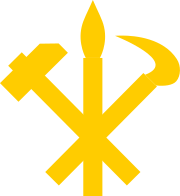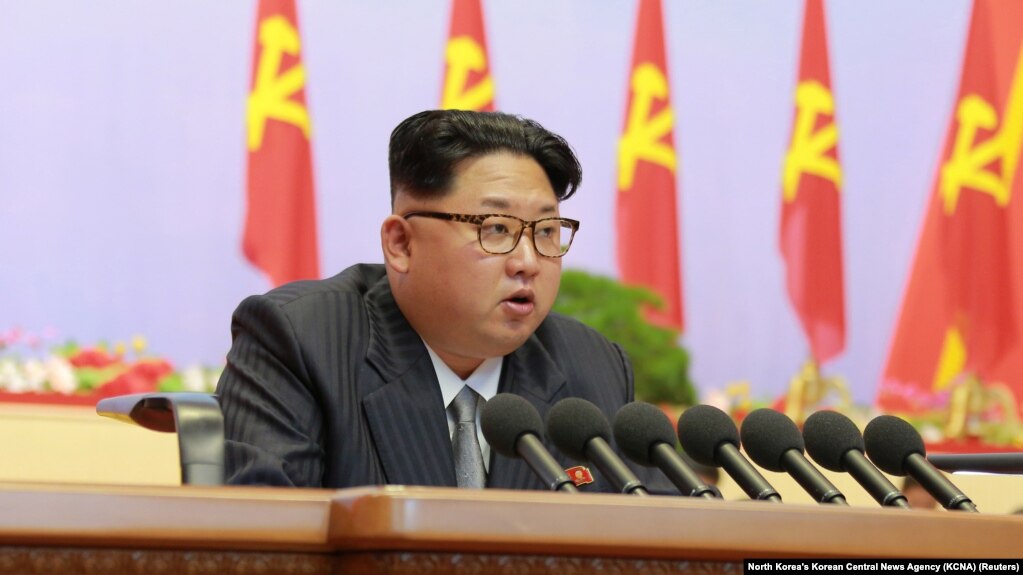Kim Jong Nuke!
Kim Jong Nuke!
Kim Jong Nuke!
https://en.wikipedia.org/wiki/Workers'_Party_of_Korea
Workers' Party of Korea
From Wikipedia, the free encyclopedia
Coordinates:
39°1′15.23″N 125°45′10.99″E
Workers' Party of Korea
조선로동당
Chosŏn Rodongdang
 Chairman Kim Jong-un
Eternal General Secretary Kim Jong-il
Chairman Kim Jong-un
Eternal General Secretary Kim Jong-il (
deceased)
Presidium
Founded June 30, 1949; 68 years ago
Merger of Workers' Party of North Korea
Workers' Party of South Korea
Headquarters Building of the Central Committee of the Workers' Party of Korea,
Pyongyang,
North Korea
Newspaper Rodong Sinmun
Youth wing Kimilsungist-Kimjongilist Youth League
Korean Children's Union
Armed wing Korean People's Army
Membership (1988) 3 million
Ideology Present:
Juche
Socialism
Songun
Historical:
Communism
Marxism-Leninism
Political position Far-left[1]
National affiliation Democratic Front for the Reunification of the Fatherland
International affiliation International Meeting of Communist and Workers' Parties
Colors Red
Anthem "Long Live the Workers' Party of Korea"
[2]
Korean: "조선로동당만세"
Menu
0:00
Status Active; Ruling party in North Korea
Outlawed in
South Korea under the
National Security Act
Supreme People's Assembly
607 / 687
Party flag
 Website
Rodong Sinmun, the official newspaper of the WPK Central Committee
Website
Rodong Sinmun, the official newspaper of the WPK Central Committee
The
Workers' Party of Korea (
WPK)
[note 1] is the founding and ruling
political party of the
Democratic People's Republic of Korea (North Korea) and the largest party represented in the
Supreme People's Assembly. The WPK is the sole governing party of North Korea, although it coexists
de jure with two other legal parties making up the
Democratic Front for the Reunification of the Fatherland. It was founded in 1949 with the merger of the
Workers' Party of North Korea and the
Workers' Party of South Korea. The WPK also controls the world's 5th largest armed force, the
Korean People's Army. This political party (and all of the other parties in the DPRK) remains illegal in
South Korea under South Korea's own
National Security Act and is sanctioned by
Australia, the
European Union, the
United Nations and the
United States.
[3]
The WPK is organized according to the
Monolithic Ideological System and the
Great Leader, a system and theory conceived by
Kim Yong-ju and
Kim Jong-il. The highest body of the WPK is formally the Congress, but in practice a Congress occurs infrequently. Between 1980 and 2016, there were no congresses held. Although the WPK is organizationally similar to
communist parties, in practice it is far less institutionalized and informal politics plays a larger role than usual. Institutions such as the
Central Committee, the
Executive Policy Bureau, the
Central Military Commission (CMC), the
Politburo and the Politburo's
Presidium have much less power than that formally bestowed on them by
the party's charter, which is little more than a nominal document.
Kim Jong-un is the current WPK leader, serving as
Chairman and CMC chairman.
The WPK is committed to
Juche, an ideology which has been described as a combination of
collectivism and
nationalism; and at the 4th Conference (held in 2012), the party charter was amended to state that Kimilsungism–Kimjongilism was "the only guiding idea of the party". At the 3rd Conference (held in 2010), the WPK removed a sentence from the preamble expressing the party's commitment "to building a
communist society", replacing it with a new adherence to
Songun, that is "military-first" policies.[
not verified in body] The 2009 revision had already removed all references to communism. Party ideology has recently focused on perceived
imperialist enemies of the party and state; and on legitimizing the
Kim family's dominance of the political system. Before the rise of
Juche and later
Songun, the party was committed to
Marxist–Leninist thought as well, with its importance becoming greatly diminished over time. The party's emblem is an adaptation of the communist
hammer and sickle, with a traditional
Korean calligraphy brush. Each symbol is to represent industrial workers (hammer), peasants (sickle) and intellectuals (ink brush).
Contents
History
Main article:
History of the Workers' Party of Korea
Workers' Party of Korea

"Workers' Party of Korea" in
Hancha (top) and
Chosŏn'gŭl (bottom) scripts
Chosŏn'gŭl 조선로동당,
북한노동당
Hancha 朝鮮勞動黨,
北韓勞動黨
Revised Romanization Joseon Rodongdang, Pukhan Nodongdang
McCune–Reischauer Chosŏn Rodongdang, Bukhan Nodongdang
Founding and early years (1945–1953)
Worker's Party!
Worker's Party!
Worker's Party!








